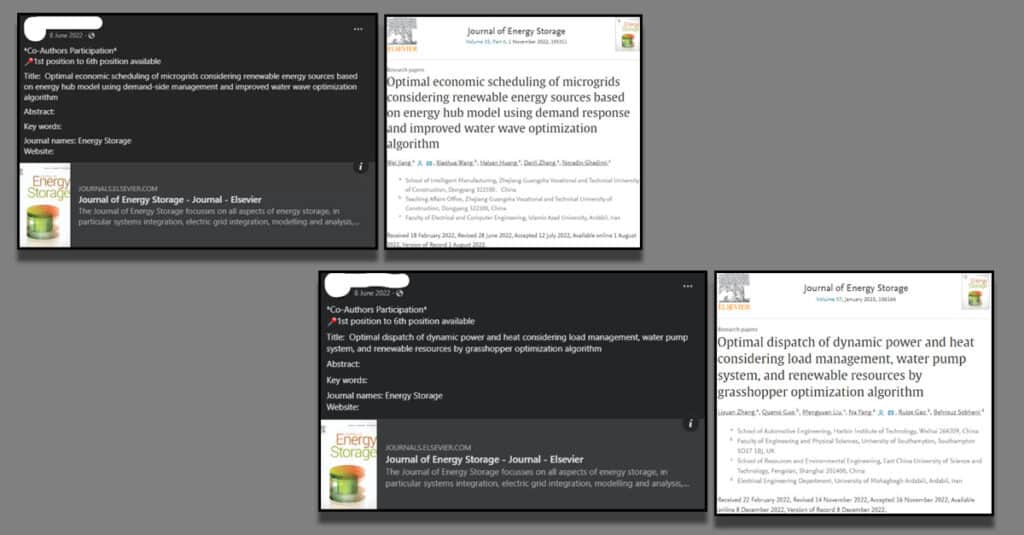The integrity of scholarly publishing assumes that research is conducted honestly, reviewed rigorously, and disseminated responsibly. Sadly, this foundation is being challenged by a growing threat: paper mills. These are commercial entities that produce and sell fraudulent academic papers, often complete with fabricated data, fake peer reviews, and ghostwritten authorship. Their services are marketed to researchers under pressure to publish, taking advantage of the “publish or perish” environment in which we operate which forces researchers to publish more papers, publish more often and rewards quantity over quality.
Paper mills are industrial-scale operations that compromise the integrity of the scientific archive, distorts metrics, and pollutes the scholarly record. Moreover, they can endanger life, for example, if false information is published in a medical journal.
Understanding the impact of paper mills is critical, not just for academics, but for institutions, journals, and the wider public who, while perhaps not understanding a lot of the science that is presented, trust that we do.
This article will explore the ways in which paper mills are damaging the integrity of the scientific archive. Indeed, we may already be past the point of no return.
You might be interested in a previous article we wrote on paper mills. We hope this article gives additional viewpoints.
Undermining Trust in Research
At the heart of science is trust – trust that data has been collected rigorously, results are reported honestly, and conclusions are valid and are supported by the statements made in the article. Paper mills shatter this trust. When fabricated or plagiarised work is published, it becomes indistinguishable from genuine research, particularly in databases and citation indexes. Scholars relying on these papers risk building their work on false premises, while the public, already confused with often conflicting scientific claims, may lose faith in academic institutions altogether.
Once published, fake studies are difficult to retract, and even those that have been retracted may have been cited and may continue to be cited. This affects every honest researcher and threatens to invalidate the integrity of the scientific archive, eventually making it meaningless or, at least, something which we can no longer rely on.
Distorting Academic Metrics
Paper mills exploit how we measure academic productivity, targeting metrics such as the number of articles published, number of citations to those articles, h-indices and impact factors. Despite what DORA is trying to achieve, this metric way of judging research is not going away anytime soon.
By flooding journals with fraudulent content, paper mills inflate the profiles of individuals who purchase these services, often leapfrogging over peers who have a more ethical approach to their own research.
Citation cartels and the buying/selling of authorships add further layers to the deception, creating a perception of highly successful researchers, which could not be further from the truth. This not only harms the integrity of the scientific archive but also affects decisions in areas such as hiring, promotions and who receives funding – which may not be based on factual data. It is also demoralising to those that play by the rules as they will see their peers flourish, while they struggle to make progress in their career.
Corrupting the Peer Review System
Paper mills may offer “peer review” as part of their package. This often involves fake reviewers, fabricated email accounts, and/or compromised editorial processes. Some journals, especially those that are poorly managed or under financial pressure, have been infiltrated by such practices. When fraudulent manuscripts bypass legitimate review, it creates a dual system, one for honest authors, and another for those paying to bypass the normal, accepted academic standards. This threatens to harm an already stretched peer review system, casting suspicion on all published research, even when it has been thoroughly peer reviewed to the stringent standards we expect.
Fueling Academic Inequality
Paper mills thrive in environments where “publish or perish” pressures are high, but where support for conducting original research is limited. This is particularly the case in institutions with weak research cultures or where academic promotion is metric driven. Those who can afford to pay for a paper mill will gain an unfair advantage, while those committed to ethical research, often with fewer resources, are sidelined. Genuine talent and potential are overshadowed by those gaming the system. In the long term, this will erode morale, give rise to inequality, and dilute the standards of scholarly achievement across the board.
Diverting Resources from Genuine Science
Every fake paper published consumes time, money, and editorial attention that could have supported real research. Peer reviewers are unwittingly asked to assess manuscripts which have no scientific value. Journal editors spend hours investigating and retracting fraudulent content. Funding bodies, hiring committees, and promotion panels are misled by inflated CVs. Moreover, addressing the wrong doings, through audits, retractions, and reputation management, diverts attention from the real research agenda.
In some cases, entire journals or special issues become compromised, with hundreds of papers requiring review. Take a look at Hindawi, which provides a concrete example of this. This is not a victimless crime; it wastes resources that academic communities can ill afford to lose.
Enabling Broader Misinformation
Research feeds into policy decisions, public health advice, media reporting, and education. When fake science enters this ecosystem, the consequences can be far-reaching. During the COVID-19 pandemic, for example, papers with questionable origins were cited in discussions on treatment efficacy and public health strategies. While many of these were later retracted, the damage had already been done. Paper mills introduce not just scientific fraud, but also social harm. In a time when fake information is rife, this is a risk that we cannot afford to ignore.
Accelerating Fraud with Generative AI
Generative AI tools, when used responsibly, can assist researchers with writing, brainstorming, and refining ideas. But in the hands of paper mills, they become tools of mass production. AI can rapidly generate text that appears coherent, cite real or plausible sounding references, and mimic academic tone without any underlying data or experimentation.
This allows fraudulent papers to be produced faster, cheaper, and with fewer obvious red flags. Some paper mills already use AI to create synthetic images, graphs, or even fake datasets, making detection ever more difficult. As these tools become more sophisticated, the scale and believability of fabricated research will likely increase.
Without rigorous checks, journals and reviewers risk being overwhelmed by high-volume, low-integrity submissions. To be honest though, and to finish on a real downer, it is unclear to me. How we can do those checks and, even if we did know, how can we find the resources to carry them out?


